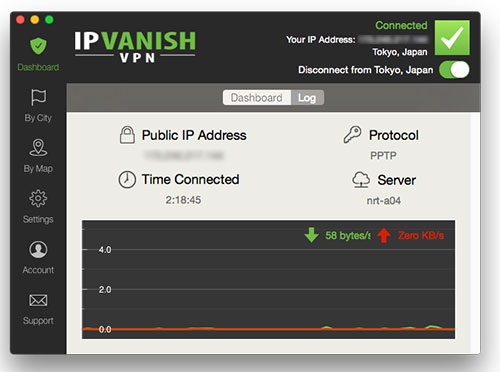

Some locations were amazing, nearing 50Mbps quite regularly, but the speeds were never consistent and often couldn’t be maintained over longer periods. In our tests, speeds were nothing special, maintaining 24.22 percent of the base speed. IPVanish offers connection options in 53 countries, with more than 1,500 servers. The first shows a straightforward list of every country IPVanish covers, as well as the number of servers in each country-or region, in the case of larger countries like the U.S. If you want a little more information, click the Server List tab where you will find another three tabs: Server, Map, and Filter. When connected, this tab also displays a usage graph, and at the top you can see your current visible IP address and general location. QuickConnect has a series of drop-down menus where you can quickly select from one of IPVanish’s more than 75 locations, as well as the city (region), and server. It offers three options on the left-hand rail: QuickConnect, Server List, and Account. For data encryption it uses 256-bit AES CBC/GCM, for data authentication it uses SHA-256, and the handshake is 2048-bit RSA.Ī nice way to describe IPVanish’s interface is “well aged.” It looks nearly the same as it did in 2017 when we reviewed IPVanish for PCWorld. Surprisingly, IPVanish doesn’t have a WireGuard implementation yet, but the company says it’s working on it.

IPVanish uses OpenVPN UDP as its default protocol there’s also OpenVPN TCP, IKEv2, IPSec, and L2TP. IPVanish for Mac with an active connection.


 0 kommentar(er)
0 kommentar(er)
